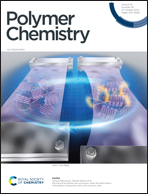Synthesis of polyimides containing Tröger's base and triphenylmethane moieties with a tunable fractional free volume for CO2 separation†
Abstract
CO2 separation from natural gas (CO2/CH4) or flue gas (CO2/N2) has a great significance for the sustainable development of the environment and society as well as industrial production. In this work, a series of rigid, bulky triphenylmethane (TPM)-derived diamines with different substituted groups (H, F, CF3, and COOH) were designed and synthesized, and subsequently introduced into the backbone of Tröger's base-based polyimide by a one-step copolymerization. Attributed to the rigid and contorted features of both triphenylmethane and Tröger's base moieties, these polyimides demonstrated simultaneously enhanced stiffness and fractional free volume. Interestingly, the viability of “tunable” fractional free volume for these polyimides could be realized by varying the substituents on the TPM-derived diamines, illustrated by their differentiated densities, fractional free volumes and d-spacings. The resulting membranes presented greatly improved separation performance for some important industrial gas pairs, such as CO2 removal from CH4 or N2. Typically, the POLY-CF3 membrane with a CF3 pendant group exhibited a largest CO2 permeability of 187.1 Barrer, almost 23 fold higher than the commercial Matrimid® 5218, accompanied by comparable CO2/CH4 ideal selectivity (30.7 vs. 34.9) while the strong interactions between CO2 and the carboxylic acid groups in the POLY-COOH membrane increased the solubility selectivity, resulting in the highest CO2/CH4 and CO2/N2 ideal selectivities.



 Please wait while we load your content...
Please wait while we load your content...